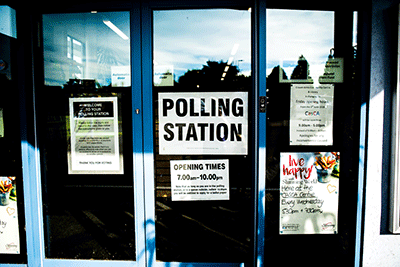New IPR Research: November 2023
Get all our news

This month's new research from IPR faculty explores gut microbiota in wild baboons that have access to trash containing processed food high in sugar, the challenges of balancing primary and general electorates, and voter perceptions of campaign promises. It also examines levels of national identification and cultural assimilation in France, school tracking and self-perception, and the motivational payoff of students.
Social Disparities and Health
Learning From ‘Garbage-Dump’ Baboons
A diet high in simple sugars and fats but low in fiber is known to have significant health effects, many of which may operate through changes in the collection of microorganisms in the gut, known as microbiota. In Scientific Reports, anthropologist and IPR associate Katherine Amato and her colleagues examine the gut microbiota in wild baboons that have access to trash containing processed food high in sugar and fat in Rwanda’s Akagera National Park. Baboons’ gut microbiota are like human ones, making them a good model for understanding the impact of diet. The researchers divided the park baboons into three groups, according to their access to human food: animals with unlimited access—“garbage-dump baboons”—those with limited access, and those with no access. Feces samples from each group, which ranged from 24 to 41 or more individuals, were collected and analyzed for microbes. Results indicated that baboons with unlimited access to human food had lower microbial diversity and fewer microorganisms involved in breaking down fiber and in producing short chain fatty acids (SCFA), which protect the gut. Baboons with limited access, however, showed only minimal changes in their gut microbiota. The findings suggest that eating processed food can change the gut microbiota among baboons, but, importantly, the amounts must be of a certain magnitude or frequency to have a strong impact. The researchers conclude that a similar “dosing threshold” could also exist for humans eating processed foods.
Politics, Institutions & Public Policy
The Challenge of Balancing Primary and General Electorates

Partisanship and Voters' Perceptions of Campaign Promises
How do voters’ political loyalties affect their view of how well politicians keep their campaign promises? In a working paper, IPR political scientist Tabitha Bonilla seeks to answer this question through two studies. In the first study, in 2019, she surveyed 547 U.S. adults, 237 Democrats and 140 Republicans, about a political candidate of their own or of the other political party, who kept their promise, broke their promise, or were unsuccessful in keeping their promise, about the highly partisan issue of immigration. Respondents were asked about their overall opinion of the candidate and how successful they found the candidate. Results revealed that respondents of both parties viewed a candidate’s success in keeping campaign promises according to the candidate’s political party. Generally, candidates of the other party seemed to be rated more for their political beliefs than for their promise keeping. In study two, in 2020, Bonilla posed a similar question to 2,303 people, with two new factors: A candidate might have no party affiliation, and respondents were asked either about immigration or human trafficking, a bipartisan issue. As in the first study, candidates of their own party were rated far more favorably than those in the other party. However, for the non-partisan issue of human trafficking, all candidates were rated similarly. Bonilla’s investigation demonstrates that voter perception of political promise fulfillment is heavily influenced by partisan beliefs when the issue is a partisan one, especially if it is unclear whether the promise was kept.
Child, Adolescent & Family Studies
National Identification and Cultural Assimilation in France
Immigrant identification, meaning how immigrants perceive themselves in relation to their host country and home country, as well as assimilation have been hot topics in recent decades. In France especially, the balance between immigrants’ allegiance to their home country and their assimilation into French culture has been especially contentious. In Social Forces, IPR sociologist Julia Behrman and Northwestern graduate student Ewurama Okai investigate the relationship between immigrants’ cultural identification and their level of assimilation. They studied 21,761 French citizens living in metropolitan France between 2008–2009 with either a foreign-born parent or a parent from a French territory who came from North Africa, sub-Saharan Africa, Turkey, Southeast Asia, or Southeast Europe. Participants in the Trajectories and Origin Survey rated their feelings about their home country and France, including “I feel French,” “I feel [my origin country or parent’s origin country],” “I feel at home in France,” and “I feel seen as French.” The researchers analyzed the data to categorize responses as either ethnic, assimilated, actively bicultural, detached bicultural, or othered bicultural. Results suggest that as national identification increases, sense of belonging increases, and as ethnic identification increases, national identification decreases. Additionally, ethnic identification decreases, and assimilation increases, from generation to generation. Last, the data shows the prevalence of biculturalism, demonstrating that feelings of French identity can co-exist with a sense of social exclusion due to migrant status. The researchers’ findings question how much immigrants' identification to their home countries threaten France’s national cohesion, as well as suggest future research topics on how complex identities are formed within societies that strongly encourage assimilation, such as that of France.
Education Policy
School Tracking and Self-Perception
![]() Separating students by academic achievement—or tracking—is a controversial policy, in part because of concern that lower-ranked children may feel stigmatized. In a recent working paper, IPR economist Ofer Malamud and his colleagues examine tracking’s effects on students’ self-perceptions in the highly tracked Romanian high school system. The researchers used educational administrative data, including test scores and grades, as well as surveys of 2,865 students and 1,843 of their teachers in 87 schools. There are almost no differences in racial and ethnic characteristics across tracks unlike the U.S., where students who attend low achieving tracks are more likely to be minority or low-income students. Romanian schools track students by a score based on tests and grades, assigning them into either a higher- or lower-achieving class. Ten students out of each class of 28 were asked to rank themselves and their peers on self-confidence, effort, ability, and expected performance. Teachers ranked the same students on the same characteristics. Analysis reveals that students just above the cutoff for the higher-achieving classes had less favorable self-perceptions than those just below in the lower-achieving classes. Students viewed peers in their own class as superior to the other, with the lower-achieving class feeling this more strongly. Students saw themselves more positively than others saw them, especially the lower-achieving students. Teachers’ assessments, when compared to academic outcomes, were far more accurate. The researchers conclude that being assigned to a lower track may not negatively affect students’ perceptions of themselves, at least while they are in high school.
Separating students by academic achievement—or tracking—is a controversial policy, in part because of concern that lower-ranked children may feel stigmatized. In a recent working paper, IPR economist Ofer Malamud and his colleagues examine tracking’s effects on students’ self-perceptions in the highly tracked Romanian high school system. The researchers used educational administrative data, including test scores and grades, as well as surveys of 2,865 students and 1,843 of their teachers in 87 schools. There are almost no differences in racial and ethnic characteristics across tracks unlike the U.S., where students who attend low achieving tracks are more likely to be minority or low-income students. Romanian schools track students by a score based on tests and grades, assigning them into either a higher- or lower-achieving class. Ten students out of each class of 28 were asked to rank themselves and their peers on self-confidence, effort, ability, and expected performance. Teachers ranked the same students on the same characteristics. Analysis reveals that students just above the cutoff for the higher-achieving classes had less favorable self-perceptions than those just below in the lower-achieving classes. Students viewed peers in their own class as superior to the other, with the lower-achieving class feeling this more strongly. Students saw themselves more positively than others saw them, especially the lower-achieving students. Teachers’ assessments, when compared to academic outcomes, were far more accurate. The researchers conclude that being assigned to a lower track may not negatively affect students’ perceptions of themselves, at least while they are in high school.
Poverty, Race & Inequality
Race, Academic Achievement, and Inequitable Motivational Payoff
Academic success is strongly associated with high motivation, but despite being similarly motivated, Black, Latinx, and Indigenous (BLI) students often receive lower grades than their White, Asian, and Asian American peers. In Nature Human Behaviour, a research team led by Northwestern PhD student David M. Silverman, with Northwestern PhD student and IPR graduate research assistant Josiah Rosario, and IPR social psychologist Mesmin Destin examine the motivational payoff of students enrolled in university and high school math courses across three studies. The first two studies analyzed patterns of motivation among 2,766 university math students. They were asked about a variety of aspects of motivation, including their expectations for success, their perceived barriers to success, and their beliefs about the nature, usefulness, and meaning of academic skills. In the third study, the researchers used similar data from 5,527 tenth graders and their teachers. The studies show that even with the same levels and patterns of academic motivation, BLI students received math grades 9% lower than their White, Asian, and Asian-American peers. The researchers also found that teachers' lower expectations of BLI students' potential to succeed in school were linked to BLI students receiving significantly lower math grades than similarly motivated non-BLI students. These studies shift attention away from reducing racial and ethnic disparities in academic achievement solely by targeting individual students' motivations, to a more nuanced understanding of the relationship between motivation and achievement, with an emphasis on the social forces that hinder educational equity.
Photo credits: Pexels and Unsplash
Published: November 28, 2023.


